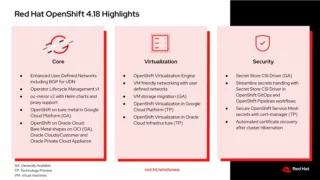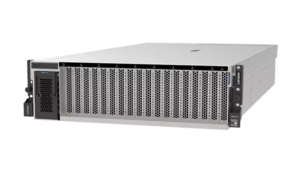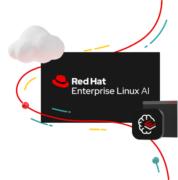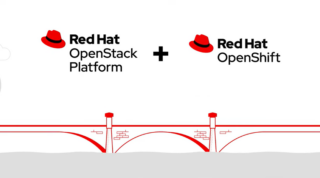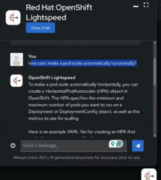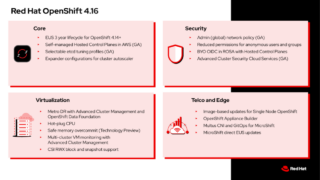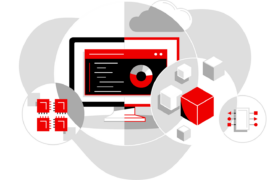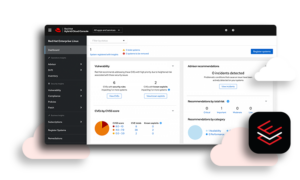Topic: red hat
Red Hat OpenShift 4.18 introduces features to meet modern virtualization needs
Red Hat has announced the release of OpenShift 4.18, which introduces several new features related to virtualization, deployment flexibility, and security. The virtualization updates are designed to improve networking, simplify storage migration, and streamline virtual machine (VM) management. User-defined networks (UDNs) are now generally available, which makes it easier for users to get virtualization running … continue reading
Red Hat unveils OpenShift Virtualization Engine, Connectivity Link offerings
Red Hat is announcing the release of two new offerings today: Red Hat OpenShift Virtualization Engine and Red Hat Connectivity Link. Red Hat OpenShift Virtualization Engine Red Hat OpenShift Virtualization Engine is a new version of OpenShift designed entirely for virtualization workloads. According to the company, this new version offers features to help deploy, manage, … continue reading
RHEL AI 1.2 adds support for new hardware accelerators from Lenovo and AMD
Red Hat has announced the latest version of Red Hat Enterprise Linux AI (RHEL AI), its platform for developing, testing, and running LLMs. “Building on the success of our initial release of RHEL AI 1.1 on September 5, 2024, this version furthers our commitment to empowering developers, AI engineers and data scientists by lowering the … continue reading
Red Hat brings AI to hybrid cloud with RHEL AI
Red Hat Enterprise Linux AI (RHEL AI) is a foundation model platform for developing, testing, and running generative AI models that enterprise applications are utilizing. It comes as a single bootable image — complete with IBM’s open source Granite LLMs and the InstructLab model alignment tools — that can be easily redeployed to servers across … continue reading
Red Hat OpenStack Services on OpenShift now generally available
Red Hat has announced the general availability release of Red Hat OpenStack Services on OpenShift (also referred to in the Red Hat portal as OpenStack Platform 18), a new OpenStack architecture that leverages the advantages of Kubernetes. It provides a new podified control plane that can be used to manage both existing OpenStack workloads and … continue reading
Red Hat OpenShift Lightspeed brings generative AI help to the platform
Using Red Hat OpenShift is about to get easier, because Red Hat is launching the developer preview of OpenShift Lightspeed, a generative AI assistant for the platform. Lightspeed can answer users’ questions about OpenShift, assist with troubleshooting, and can offer insights on building, deploying, and managing hybrid cloud applications. For instance, a user could ask … continue reading
Red Hat OpenShift 4.16 now available with several new virtualization features
Red Hat has announced the latest version of OpenShift, its Kubernetes-based application development and deployment platform. “Being able to more quickly modernize both infrastructure and applications are crucial capabilities to better support customer needs — but this can’t be done overnight,” said Mike Barrett, vice president and general manager of Hybrid Cloud Platforms at Red … continue reading
Red Hat Enterprise Linux looks to the future of AI with Image Mode for RHEL
Red Hat today introduced Image Mode for Red Hat Enterprise Linux (RHEL), a new deployment method that delivers the platform as a container image. According to Red Hat’s announcement, Image Mode for RHEL gives Linux, which already sits at the core of containers, a container-native approach to building, deploying and managing the operating system. Using … continue reading
KubeCon + CloudNativeCon Europe 2024: Istio 1.22, profiling support in OpenTelemetry, wasmCloud 1.0, and more
KubeCon + CloudNativeCon Europe 2024 is taking place from today until Friday in Paris, France. The event is an annual gathering of Kubernetes operators that is put on by the CNCF and Linux Foundation. The CNCF has announced updates to some of its projects, and a number of vendors also released new things at the … continue reading
Red Hat partners with several companies on multiple network sustainability initiatives
Red Hat is attempting to tackle the challenge of sustainability in telecom networks with a number of new innovations from partnerships that are being highlighted at MWC in Barcelona this week. According to the company, AI can be a useful tool in this initiative, however there are many challenges to solve, such as collecting enough … continue reading
ITOps Times Open-Source Project of the Week: Strimzi
The CNCF Technical Oversight Committee (TOC) has voted to accept Strimzi as a CNCF incubating project. Strimzi simplifies the deployment and management of Apache Kafka clusters on Kubernetes, leveraging the operator pattern to ease installation, upgrades, and security tasks. Apache Kafka, known for its scalability and fault tolerance, is widely used for building event-driven architectures … continue reading
Red Hat Enterprise Linux 9.3 released, RHEL 8.9 out in a few weeks
Red Hat has announced the release of Red Hat Enterprise Linux (RHEL) 9.3, with Red Hat Enterprise Linux 8.9 coming in the next few weeks. These releases include updates designed to support containers, including an expansion of the Podman integration already present in RHEL. Podman is a tool for deploying, running, building, and sharing Linux … continue reading

